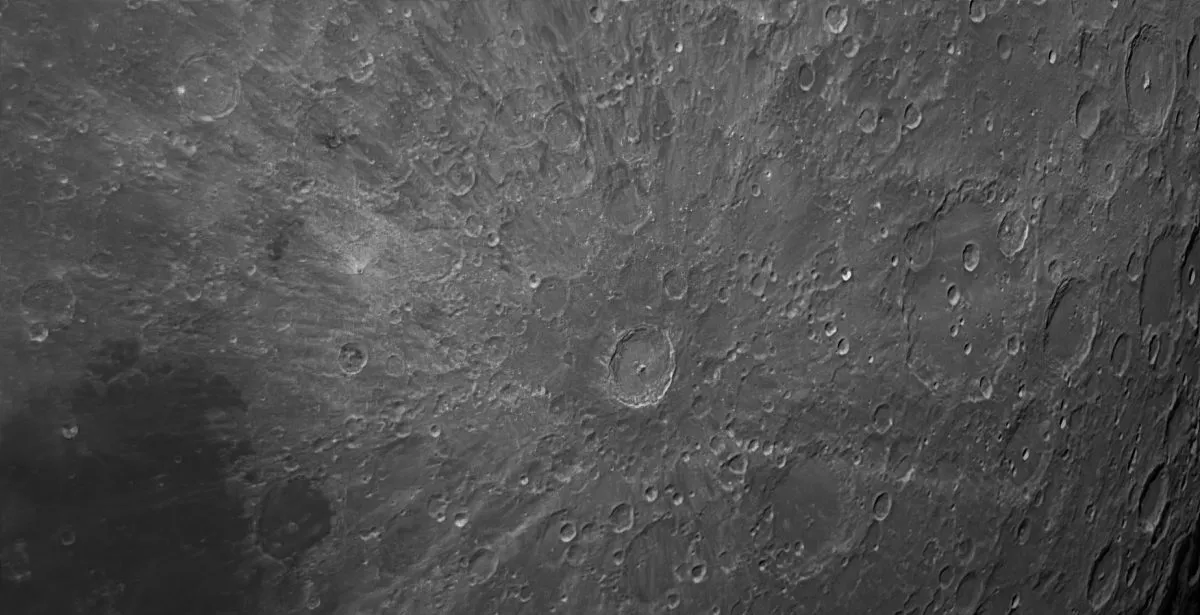Crater Pitatus is an old and prominent feature at the southern end of the Mare Nubium, the Sea of Clouds – it almost appears to be an extension of the sea.
In many cases where large, high-walled craters lie close to the edge of a lava basin, the basin lava has broken through the ramparts to resurface the crater floor.
In the case of Pitatus, it’s believed the floor lava welled up from within the crater itself.
For more info on getting the most out of the Moon, read our guide on how to observe the Moon and the best features on the Moon.

Facts about Crater Pitatus
- Size: 98km
- Age: Between 3.85 and 3.92 billion years
- Location: Latitude 29.9°S, longitude 13.5°W
- Recommended kit: 4-inch telescope
The three-quarter, octagonal-shaped rim appears eroded to the north. Pitatus’s smooth floor has a small, central mountain.
A rough hilly region lies north of the mountain but the rest of the floor is relatively smooth with just a few tiny craterlets and a number of subtle domes, visible when the terminator is near.
Things start to get interesting closer to the rim. Acurious crack, or rille, runs parallel to it.
Using a 10-inchscope under steady seeing, the rille can be spotted close to the northern edge of the rim.

It follows the inside profile of the crater to the east and round to the southeast.In high-resolution images, you can follow this crack virtually all the way round.
A thin rille appears to join the rim to the central mountain to the southwest.
The western rim is odd because it appears gouged out; it’s almost as if a giant finger has been run along it, causing a groove.
Closer inspection suggests this is a line of small craters, perfectly aligned to the curve of the rim.
The ray crater Tycho lies 410km to the south and slightly east of Pitatus. During the fuller phases of the Moon, bright Tycho Crater (86km wide) and dark Pitatus (98km) look like negatives of one another.
When the Sun is high in the lunar sky, Pitatus’s floor looks dark, but look closely and you should be able to see patches ofbright ejecta from Tycho, which is roughly one-third theage of Pitatus.

Pitatus touches crater Hesiodus (43km) to the west. They are connected by a gap in their rims.
Hesiodus has a tiny 5km craterlet at its centre called Hesiodus D. However, the real treat is Hesiodus A (15km), which touches the southern wall of its parent crater. The floor of Hesiodus A contains two concentric rings.
Located 73km to the north of Pitatus’s centre is a superb horseshoe crater called PitatusS. Here, a perfectly circular crater has become flooded by Mare Nubium lava.
However, not all the crater has disappeared – a delicately thin semicircle of crater wall can still be seen.
While Pitatus is pretty ancient, to the south of it lie two even older craters in the form of Gauricus (80km) and Wurzelbauer (88km).
Gauricus has a smooth round cross-sectioned rim surrounding a flat crater floor. Wurzelbauer looks really ancient. Here the rim is ill defined and rather ragged.
The floor is old and weathered – extremely rough in contrast to its neighbour.
Another feature worth spotting in Mare Numbium is Rupes Recta.
